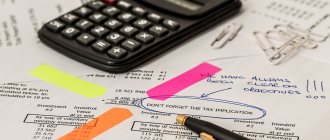What is an income statement
This is a form included in the financial statements along with the balance sheet and its annexes. The report form was approved by Order of the Ministry of Finance dated 07/02/10 No. 66n (hereinafter referred to as Order No. 66n).
IMPORTANT . The income statement format is not recommended. Using it is an obligation, not a right of organizations. But the company can set the level of detail itself. For example, decipher what business expenses consist of and enter an additional line “Including” for this.
By the way, previously this form was called “profit and loss statement” and “form No. 2”. The modern name was introduced more than six years ago, but some accountants, auditors and other specialists still use the old name.
Peculiarities of interconnection of financial reporting indicators
There are a number of key accounting indicators, the values of which must correspond to each other.
That is, they are equal. And only in this case can we say that there has been an interconnection of the indicators of the financial reporting forms. If we reason by analogy with tax reporting, unfortunately, the control ratios of accounting reporting that must be observed are not given in any regulatory document. They were developed by accounting practice.
Please note that the composition of the financial statements has not changed in recent years. It is still approved by order of the Ministry of Finance of Russia dated July 2, 2010 No. 66n. This means that the control ratios to the financial statements for 2021 do not differ from previous reporting periods.
Even if an organization has modified the basic accounting report forms for its needs, the interconnection of the indicators of the accounting reporting forms must still be observed!
Constantly checking the interrelation of indicators in the financial reporting forms will help to quickly find and correct all errors and shortcomings. At the same time, each organization decides for itself how to monitor correlated reporting indicators (lines).
Where are Forms 2 of the financial results statement?
There is a form designed for all organizations (let's call it the general form). It is given in Appendix No. 1 to Order No. 66n. The filling rules given below relate specifically to the general form of the financial results report (on the active link you can use Form 2 of the financial results report).
Small businesses can use a special simplified form. It is given in Appendix No. 5 to Order No. 66n.
Fill out your income statement and other financial statements for free
REFERENCE . The financial results report for 2021 and later periods will need to be submitted using an updated form. Amendments to the current form were made by order of the Ministry of Finance dated April 19, 2019 No. 61n. The changes are related to the new edition of PBU 18/02 (see “Instructions for the new edition of PBU 18/02 “Accounting for corporate income tax calculations”, which must be applied from 2021”). Organizations may wish to apply the updated form earlier.
Prepare, check and submit financial statements to the Federal Tax Service via the Internet Submit for free
Why is it necessary to interconnect indicators of annual financial reporting forms?
Checking the relationship is carried out in order to control the correctness and completeness of reports before they are submitted to government agencies. The testing procedure is established by each business entity independently. The main criteria can be found in Law No. 402-FZ, Regulation No. 4/99. At the same time, the interconnection of indicators of the forms of financial statements of a small enterprise, as a rule, is carried out in relation to the balance sheet in Form 1 and the report on financial results of Form 2. If the organization reports in full, it is necessary to compare the control ratios of the indicators of all mandatory forms of financial statements.
The legislation does not establish clear regulations for the procedure. The accountant of an enterprise, first of all, needs to compare data on tax and accounting, information on financial results in forms 1 and 2, information within and between individual types of reports. Tax employees perform similar actions and, if discrepancies are detected, they require the company to provide explanations (Article 88, paragraph 3 of the Tax Code) and submit clarifications if errors are identified. In some situations, discrepancies in reports cause the organization to be included in the plan for on-site or desk audits.
How to fill out an income statement
The purpose of filling out is to show how the totals were calculated:
- Gross profit (loss);
- profit (loss) from sales;
- profit (loss) before tax;
- Net income (loss).
Each final value is obtained by adding or subtracting intermediate values. For example, to find gross profit, you first need to take two intermediate indicators: revenue and cost of sales. Then subtract the second from the first.
IMPORTANT. Intermediate values that participate in calculations with a minus sign (that is, are subtracted) must be indicated in parentheses. Some indicators are always in parentheses: business expenses, interest payable, etc. But there are also those that can be either in brackets or without them. This is a change in deferred tax assets (DTA) and a change in deferred tax liabilities (DTL).
All lines have an “Explanation” column. It contains the number of explanations that disclose information on this line. If, for example, information about revenue is summarized in a certificate with number 15, then before the line “Revenue” you need to put “15”.
ATTENTION. Previously, financial statements could be filled out in both thousands and millions of rubles. But, starting with reporting for 2021, there is only one option left - in thousands of rubles. These amendments to order No. 66n were made by order of the Ministry of Finance dated 04/19/19 No. 61n.
Maintain accounting and tax records for free in the web service
Consultant's blog
Content
hide
1 Basic financial statements
2 Cash and accrual basis
3 Balance
4 Statement of financial results (P&L) 4.1 Relationship between the income statement and the balance sheet
5 Cash flow statement (CFDS, CF) 5.1 What is the usefulness of the report?
6 Results
Basic financial reports
As soon as we talk about finances, managers and owners remember three basic financial reports that are a must have for any business. But unfortunately, the majority of them do not know how to properly analyze and compile them, and sometimes invent their own forms of these reports, which they consider the only correct ones.
These three types of reports are:
- Balance
- Financial result report
- Cash flow statement
Each of these reports is compiled according to a specific methodology and displays some useful information for users of these reports.
The balance sheet displays the financial position of a company as of a specific date, the income statement displays the company's performance for a specific period, and the cash flow statement displays the directions and flows of a business's cash flows.
Cash and accrual method
Before we start looking at each report separately, I would like to remind you that there are two ways to record income and expenses: accruals and cash.
Why do I remember this? Yes, because many entrepreneurs consider their financial results using the cash method, which is fundamentally wrong.
Let's look at each method separately.
The difference between these methods lies in the method of reflecting income and expenses for the selected accounting period. Those. in which business transactions for the period are considered expenses and which are income. It is clear that during the entire existence of the enterprise, all receipts of money are income, and all payments are expenses. But we are not interested in the entire working time, but in each specific period. Quarter, month, week or even day. When we divide our time line into segments, the difference arises.
Under the cash method, income is considered to be any receipt of funds in the cash register or to a current account, and expenses are any payment or disbursement made during the accounting period. In this case, the relationship between income and expenses for the same period does not matter. We bought vodka, sold an hour of karaoke - it’s still income and expense.
Under the accrual method, income for a period is considered to be the sales value of goods sold and services provided in this period, regardless of their payment. And an expense is considered to be the cost of goods and services sold, as well as the enterprise’s consumption of goods and services, and also regardless of their payment to the supplier. Those. if Borscht is income, then everything related to this Borscht is considered an expense - food, cook’s salary, hall rent, electricity, etc. Those. everything that led to the opportunity to realize this particular Borscht.
Which method is better?
It depends on situation.
The cash method is easier to implement because... is based on data from payment systems, which is very easy to collect - they are reflected in the cash register or banking system and are always confirmed by primary documents. In addition, the result of this method - profit - coincides with the cash balance, i.e. can be easily verified (by cash count).
The accrual method is more complicated, and its profit does not coincide with the cash balance, but it is more accurate in the sense that if the profitability or efficiency of the enterprise is calculated by the profit received, then it makes more sense, because income, expense and profit are interrelated.
Read: Methods for preparing a cash flow statement
The difference between them can be illustrated by the example of gasoline consumption in a car. Gas mileage is something we use to measure the “efficiency” of a car (and driving style). The lower the gas mileage, the better.
The “accrual method” is when we compare the distance traveled during a period with the volume of gasoline consumed during the same period. For this we use the on-board computer. We can drive 100 km in one week and spend 7 liters (7 l/100km), and drive 1000 km in another week and spend 60 liters (6 l/100km). Obviously, in the second week we drove more economically or “more efficiently”.
The “cash method” is when we compare the distance traveled during a period with the volume of gasoline purchased (filled in the tank) during the same period. We can fill 50 liters in one week and drive 1 km (5000 l/100km), and the next week add another 1 liter and drive 100 km (1 l/100km). Obviously, the results are not comparable, they make no sense.
This leads to a very simple conclusion:
Profit is not equal to money in the cash register. To analyze the “money” indicator, a cash flow statement is used; to analyze the “profit” indicator, a profit and loss statement is used.
Balance
A balance sheet is a snapshot of your business as of a specific date. And shows the financial condition of the company.
What can you use balance for?
- Answer the question: where is the money? (on the account, in the product,….)
- You can see the results and balances, find out how much fixed assets, goods, debt we have;
- To calculate financial ratios;
- Determine the book value of the business.
In short, here's what you need to remember:
- In any business there is a balance;
- Assets = Liabilities;
- Assets show what belongs to the company, liabilities show the company’s debts;
A good balance is when:
- The balance sheet currency is growing;
- There are more current assets than non-current assets
- Equity capital is greater than debt capital
- The growth rate of debtors is the same as that of creditors.
The balance sheet itself has the following structure:
On the left side we see information about the assets the company has, while on the right side the sources of origin of these assets are deciphered. These sources can be either own or borrowed.
Equality of the balance is ensured by the fact that each accounting transaction is displayed on two accounting accounts, with one account as a debit and the other as a credit.
All transactions that are displayed in accounting can be divided into 4 types:
- The operation affects only assets: A+X-X=P
- The operation affects only liabilities: A = P+X-X
- The operation increases both assets and liabilities: A+X=P+X
- The operation reduces both assets and liabilities: A-X=P-X
At the same time, the balance sheet is very closely related to other financial reports and accumulates the results of other reports.
This connection lies in our accounting identity:
Assets = Equity – Equity Withdrawals + Income – Expenses
The financial result is included in the Balance Sheet item – “Retained Earnings”, which is included in equity capital.
And cash flow is nothing more than the difference between the Balance Sheet item “Cash” between the beginning and end of the period.
Statement of financial results (P&L)
This report has many names, but its essence is the same - displaying the financial results of activities for a certain period and deciphering the components of income and expenses.
What are the purposes of using this report?
- See the financial result and its components
- Calculate important financial ratios: marginality, profitability
- Calculate break-even point
- Have an idea of the value of the business
Read: Accounting as an information system. MIS. Main users of accounting information
Briefly, the scheme for constructing this report can be presented as follows:
The income and expense items in the management income statement can be detailed to the required level, but the structure will remain the same.
This report is prepared on an accrual basis, and not on the basis of cash receipts or expenditures. If you calculate it based on money, then it is no longer P&L.
Let's take sales revenue for example. It is considered based on fulfilled obligations, upon shipment of goods, upon provision of services. Revenue is confirmed by acts of signed services or invoices. Revenue is shown excluding indirect taxes (for example, VAT).
What a manager needs to know about this report:
- This report must be completed;
- Income and expenses are shown on an accrual basis;
- The rule of periods should be followed: expenses are recognized simultaneously with the income for which they were incurred, especially with regard to the cost of inventories;
- Indirect taxes do not participate in the formation of the financial result (but this rule has exceptions)
Relationship between the income statement and the balance sheet
The income statement and balance sheet in no way replace each other, since they perform different functions. The balance sheet, as already mentioned, shows the financial position of the company at one time or another; it is a “snapshot” of the assets owned by the company. And the income statement shows the flow of profits for the period. There is a direct connection between the two reporting forms.
The income statement links the balance sheets at the beginning of the period and at the end of the reporting period. Thus, at the beginning of a new reporting period, the balance sheet shows the initial financial position of the company. After some time, an income statement is prepared, showing how much profit the company made during the period, and a balance sheet, reflecting the company's new financial position at the end of the period. This balance sheet shows the changes that have occurred since the previous balance sheet date.
Cash Flow Statement (CFDS)
Many managers do not understand that a company's profit is not necessarily related to the money it receives. Yes, ultimately the company must make a profit in monetary terms, and if you take a long enough period of time, the income statement and cash flow statement will show the same numbers.
To develop a company, money is needed, and if the company is actively developing, it may not be enough and it begins to actively look for it on the side. In order for a potential investor to understand where the company’s money comes from, the ODDS was invented. It shows how much money the company had at the beginning of the reporting period, how much it had at the end, and why the initial and final values are different.
The report itself is prepared on a cash basis. And this is the first report that the manager draws up, even before he even thinks about the reporting system.
Why is this report being prepared?
- to know how much money is in the business, to predict cash gaps and the need for financing;
- analyze the company's cash flows;
- trace the relationship between cash flow and profit.
The report itself has three standard sections:
- Cash flow from core activities;
- Cash flow from investing activities;
- Cash flow from financing activities
These sections can be interpreted as follows:
- The company received X UAH. from its main activity;
- she spent Y UAH on her development;
- the company borrowed Z UAH.
Classic financial ODDS can be compiled by two methods: direct and indirect.
The direct method lists all major cash flow items separately. Then the amounts of payments made are subtracted from cash receipts.
Read: The influence of the accountant’s assumptions and estimates when preparing the income statement on its performance
In the indirect method , net income is recorded and then adjusted in accordance with the data necessary to determine on its basis the amount of net cash flow received or expended from operating activities.
An example of an ODDS compiled by the indirect method
| Cash flows from operating activities | |
| Net profit | 3 000 000 |
| Adjustments: | |
| Depreciation and amortization | 125 000 |
| Provision for losses on accounts receivable | 20 000 |
| Profit from the sale of an object | (65 000) |
| 80 000 | |
| Increase in trade receivables | (250 000) |
| Inventory reduction | 325 000 |
| Reduction of accounts payable | (50 000) |
| 25 000 | |
| Cash received from operations | 3 105 000 |
| Cash flows from investing activities | |
| Acquisition of fixed assets | (500 000) |
| Proceeds from the sale of equipment | 35 000 |
| Net cash used in investing activities | (465 000) |
| Cash flows from financing activities | |
| Proceeds from the issue of ordinary shares | 150 000 |
| Proceeds from the issue of long-term debt obligations | 175 000 |
| Dividends paid | (45 000) |
| Net cash used in financing activities | 280 000 |
| Net increase in cash and cash equivalents | 2 920 000 |
| Cash and cash equivalents at the beginning of the period | 2 080 000 |
| Cash and cash equivalents at the end of the period | 5 000 000 |
Whatever method you use, the result will be the same. The indirect method provides a better understanding of how cash flow from operating activities differs from profit. In addition, it is easier to compose, which is why many companies use it.
Why is the report useful?
This report is of interest to many users. Since it helps to identify possible manipulations with financial reporting data. The data in this report is very easy to check by simply looking at the cash flow across the accounts. They simply cannot be made artificially. Therefore, if, when analyzing the statements, you see a significant increase in profit, which is not accompanied by a significant increase in cash flow, then you need to be wary and analyze the reasons for the increase in such profit.
If a company has a negative cash flow, this does not mean that it is unprofitable. The company just needs to look for additional financing for its business.
What a manager needs to remember about this report:
- You must have this report;
- Compilation rules: on a cash basis;
- This report should not contain the words: Income or expenses, there are receipts and payments of funds;
- The rest of the money is not profit. Don't look for it in your safe. Net cash flow is not a measure of how much a company makes
Results
We have looked at three basic financial statements that almost every company has. All of these reports are interconnected and are just top-level reports and are essentially the icing on the cake of your financial reporting system, which also includes operational and analytical reports.
When preparing reports, remember that it should be:
- Structural – reporting is a system, and it should be closely woven into the structure of your company.
- Sufficient - it should not be redundant.
- Valuable - it must be compiled if it is used, otherwise it is meaningless. There is no need to make a report for the sake of the report itself.
- Reliable – you must trust the figures in the reporting.
- Timely - detailing reports is good, but if it is done, and the need for it has disappeared, then such a report is not needed.
Example of filling out a financial results report (sample)
In 2021, the trading organization's performance was as follows:
- revenue 12,000,000 rub. (including VAT 20% - RUB 2,000,000);
- purchase price of goods is 6,000,000 rubles. (including VAT 20% - RUB 1,000,000);
- commercial expenses (for warehousing goods and staff salaries) - RUB 1,500,000;
- interest payable (for using a bank loan) - 500,000 rubles;
- current income tax - 600,000 rubles.
The company did not apply PBU 18/02 and did not form ONA, ONO, PNA and PNO.
The accountant found the totals.
Gross profit - 5,000,000 rubles ((12,000,000 - 2,000,000) - (6,000,000 - 1,000,000)).
Profit from sales - 3,500,000 rubles (5,000,000 - 1,500,000).
Profit before tax - 3,000,000 rubles (3,500,000 - 500,000).
Net profit - 2,400,000 rubles (3,000,000 - 600,000).
The accountant filled out the financial results report as shown in Table 2.
table 2
Report on financial results of a trading company for 2019 (thousand rubles)
| Explanations | Indicator name | For 2021 |
| Revenue | 10 000 | |
| Cost of sales | (5 000) | |
| Gross profit (loss) | 5 000 | |
| Business expenses | (1 500) | |
| Administrative expenses | ||
| Profit (loss) from sales | 3 500 | |
| Income from participation in other organizations | ||
| Interest receivable | ||
| Percentage to be paid | (500) | |
| Other income | ||
| other expenses | ||
| Profit (loss) before tax | 3 000 | |
| Current income tax | (600) | |
| incl. permanent tax liabilities (assets) | ||
| Change in deferred tax liabilities | ||
| Change in deferred tax assets | ||
| Other | ||
| Net income (loss) | 2 400 |
Table 3
The relationship between the balance sheet and the income statement
| Balance indicator | Income statement indicator | Note |
| Line “Retained earnings (uncovered loss) (1370) The difference between the column “As of December 31 of the previous year” and the column “At the end of the reporting period” | Line “Net profit (loss)” (2400) Value at the end of the reporting period | Equal if there were no turnovers on account 84 in the reporting period (not counting balance sheet reformation) |
| Line “Deferred tax assets” (1180) The difference between the column “As of December 31 of the previous year” and the column “At the end of the reporting period” | Line “Change in deferred tax assets” (2450) Value at the end of the reporting period | Equal if SHE and IT are shown expanded in the balance sheet |
| Line “Deferred tax liabilities” (1420) The difference between the column “As of December 31 of the previous year” and the column “At the end of the reporting period” | Line “Change in deferred tax liabilities” (2430) Value at the end of the reporting period | Equal if SHE and IT are shown expanded in the balance sheet |
Fill out and print your balance sheet using the current form for free
Control ratios to financial reporting indicators 2021
The benchmark indicators in force in 2021 are publicly available to all taxpayers on the official website of the Federal Tax Service. Using these values, it is checked under what conditions and with what the specified data must match. A table with individual indicators is posted below.
Interrelation of the main indicators of financial statements - table 2021:
| Form 1 “Balance Sheet” | Form 2 “Report on financial results” |
| Page 1180 OHA (calculation is done by subtracting the data in columns 4 and 5) | Page 2450 SHE in column 4 |
| Page 1180 OHA (calculation is done by subtracting the data in columns 5 and 6) | Page 2450 SHE in column 5 |
| Page 1370 “Retained earnings” in column 4 | Page 2400 in column 4 “Net profit” |
| Page 1370 “Retained earnings” in column 5 | Page 2400 in column 5 “Net profit” |
| Page 1420 IT (calculation is performed by subtracting data from columns 4 and 5) | Page 2430 “Changes to IT” in column 4 |
| Page 1420 IT (calculation is performed by subtracting data from columns 5 and 6) | Page 2430 “Changes to IT” in column 5 |
| Form 1 “Account balance” | Form 3 “Report on changes in capital” |
| Page 1310 in column 6 “Authorized capital” | Page 3100 in column 3 “Authorized capital” |
| Page 1310 in column 5 “Authorized capital” | Page 3210 in column 3 “Increase in total capital” |
| Page 1360 in column 6 “Reserve capital” | Page 3100 in column 6 “Reserve capital” |
| Page 1360 in column 5 “Reserve capital” | Page 3210 in column 6 “Increase in total capital” |
| Page 1370 in column 5 “Retained earnings” | Page 3200 in column 7 “Increase in total capital” |
| Page 1370 in column 6 “Retained earnings” | Page 3100 in column 7 “Retained profit/loss” |
| Page 1350 in column 4 “Additional capital” excluding the amount of revaluation | Page 3300 in column 5 “Capital value as of 31.12” |
| Page 1370 in column 4 “Retained profit/loss” | Page 3300 in column 7 “Capital value as of 31.12” |
| Page 1300 in column 4 “Total amount of section III” | Page 3300 in column 8 “Capital value as of 31.12” |
| Form 1 “Account balance” | Form 4 “DDS Report” |
| Page 1250 in column 5 “Cash and, if available, equivalents” | Page 4450 in column 3 “Balance at the beginning of the amount of funds” |
| Page 1250 in column 4 “Cash, and, if available, equivalents” | Page 4500 in column 3 “Balance at the end of the amount of funds” |
| Page 1250 in column 6 “Cash, and, if available, equivalents” | Page 4450 in column 4 “Balance at the beginning of the amount of funds” |
The given examples of checking the relationship are carried out according to the 2016 rules. It is recommended to cross-check the data before each submission of reports. This will help you draw up the forms correctly and minimize possible claims from regulatory authorities.
How to present
Until recently, companies could choose in what form to submit their financial statements: on paper or via the Internet.
But as of reporting for 2021, there is only one way left - to submit the balance sheet and other forms via the Internet (via telecommunication channels through an electronic document management operator).
An exception is made only for small businesses. At the end of 2021, they can submit reports, including financial results, on paper. But based on the results of 2020 and later periods, general rules will apply to them. Such changes were made to the Accounting Law by Federal Law No. 444-FZ dated November 28, 2018.





